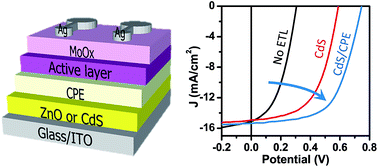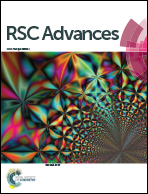Solution-processed, inverted organic solar cells with bilayered inorganic/organic electron extraction layers†
Abstract
In this work, we introduce a solution-processed CdS interlayer for use in inverted bulk heterojunction (BHJ) solar cells, and compare this material to a series of standard organic and inorganic cathode interlayers. Different combinations of solution-processed CdS, ZnO and conjugated polyelectrolyte (CPE) layers were compared as cathode interlayers on indium tin oxide (ITO) substrates to construct inverted solar cells based on poly[[4,8-bis[(2-ethylhexyl)oxy]benzo[1,2-b:4,5-b′]dithiophene-2,6-diyl][3-fluoro-2-[(2-ethylhexyl)carbonyl]thieno[3,4-b]thiophenediyl]]:[6,6]-phenyl-C71-butyric acid methyl-ester (PTB7:PC71BM) and a poly(3-hexylthiophene):[6,6]-phenyl-C61-butyric acid methyl ester (P3HT:PC61BM) as photoactive layers. Introduction of a CdS interlayer significantly improved the power conversion efficiency (PCE) of inverted PTB7:PC71BM devices from 2.0% to 4.9%, however, this efficiency was still fairly low compared to benchmark ZnO or CPE interlayers due to a low open circuit voltage (VOC). The VOC was greatly improved by introducing a conjugated polyelectrolyte (CPE) layer on top of the CdS layer, yielding outstanding diode characteristics and a PCE of 6.8%. These results indicate that the deep conduction band energy of CdS limits the VOC possible when used as an ETL in polymer fullerene solar cells, however, we have discovered that this issue can be readily overcome via the incorporation of an organic interfacial dipole layer. The best performing interlayer, however, was a single CPE layer alone, which yielded a VOC of 0.727 V, a FF of 63.2%, and a PCE of 7.89%. Using P3HT:PC61BM as an active layer, similar trends were observed. Solar cells without the cathode interlayer yielded a PCE of 0.46% with a poor VOC of 0.197 V and FF of 34.3%. In contrast, the use of inorganic/organic ZnO/CPE interlayers as the cathode interlayer considerably improved the VOC of 0.599 V and FF of 53.3%, resulting in a PCE of 2.99%. Our results indicate that the CdS layer yields excellent diode characteristics, however, performs slightly worse than benchmark ZnO and CPE layers in solar cell devices due to parasitic absorption below 550 nm. These results suggest that layered inorganic/organic interfacial materials are promising candidates as cathode interlayers for high efficiency inverted solar cells through the modification of interfacial contacts.


 Please wait while we load your content...
Please wait while we load your content...